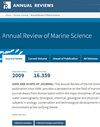The Marine Organic Sulfur Cycle
IF 18.9
1区 地球科学
Q1 GEOCHEMISTRY & GEOPHYSICS
引用次数: 0
Abstract
Organic sulfur (OS) in the ocean is produced in vast quantities by primary producers that fix inorganic sulfate into proteins, metabolites, and other ubiquitous biomolecules. As biogenic OS is transported and transformed through the marine environment, it is joined by OS from two additional sources: abiogenic OS from sulfurization under anoxic conditions, and geological OS from the weathering of sediments and rocks. Important differences in the properties of the OS from these sources affect its fate in the environment and underlie the formation of recalcitrant dissolved organic matter and sedimentary kerogen. This review builds connections between the rapid OS cycle in the surface ocean and these longer-lived reservoirs, applying our growing knowledge of particle fluxes and organic matter dynamics at the sediment–water interface. Future studies on marine OS are poised to help us better understand the implications of these fluxes for the carbon cycle and climate across human and geological timescales.海洋有机硫循环
海洋中的有机硫(OS)是由初级生产者大量生产的,它们将无机硫酸盐固定在蛋白质、代谢物和其他无处不在的生物分子中。当生物OS通过海洋环境运输和转化时,还会有两个额外来源的OS加入:缺氧条件下硫化产生的非生物OS和沉积物和岩石风化产生的地质OS。这些来源的OS性质的重要差异影响了其在环境中的命运,并成为顽固溶解有机质和沉积干酪根形成的基础。本文运用我们在沉积物-水界面的颗粒通量和有机质动力学方面不断增长的知识,在海洋表面的快速OS循环和这些寿命较长的储层之间建立了联系。未来对海洋生态系统的研究将帮助我们更好地理解这些通量对人类和地质时间尺度上的碳循环和气候的影响。
本文章由计算机程序翻译,如有差异,请以英文原文为准。
求助全文
约1分钟内获得全文
求助全文
来源期刊

Annual Review of Marine Science
地学-地球化学与地球物理
CiteScore
33.60
自引率
0.60%
发文量
40
期刊介绍:
The Annual Review of Marine Science, published since 2009, offers a comprehensive overview of the field. It covers various disciplines, including coastal and blue water oceanography (biological, chemical, geological, and physical), ecology, conservation, and technological advancements related to the marine environment. The journal's transition from gated to open access through Annual Reviews' Subscribe to Open program ensures that all articles are available under a CC BY license, promoting wider accessibility and dissemination of knowledge.
 求助内容:
求助内容: 应助结果提醒方式:
应助结果提醒方式:


